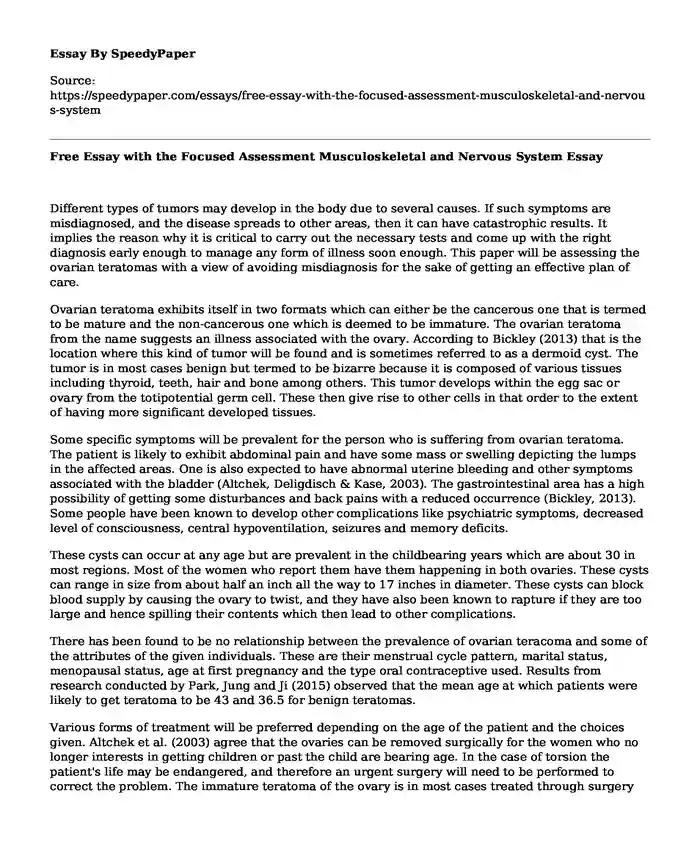Different types of tumors may develop in the body due to several causes. If such symptoms are misdiagnosed, and the disease spreads to other areas, then it can have catastrophic results. It implies the reason why it is critical to carry out the necessary tests and come up with the right diagnosis early enough to manage any form of illness soon enough. This paper will be assessing the ovarian teratomas with a view of avoiding misdiagnosis for the sake of getting an effective plan of care.
Ovarian teratoma exhibits itself in two formats which can either be the cancerous one that is termed to be mature and the non-cancerous one which is deemed to be immature. The ovarian teratoma from the name suggests an illness associated with the ovary. According to Bickley (2013) that is the location where this kind of tumor will be found and is sometimes referred to as a dermoid cyst. The tumor is in most cases benign but termed to be bizarre because it is composed of various tissues including thyroid, teeth, hair and bone among others. This tumor develops within the egg sac or ovary from the totipotential germ cell. These then give rise to other cells in that order to the extent of having more significant developed tissues.
Some specific symptoms will be prevalent for the person who is suffering from ovarian teratoma. The patient is likely to exhibit abdominal pain and have some mass or swelling depicting the lumps in the affected areas. One is also expected to have abnormal uterine bleeding and other symptoms associated with the bladder (Altchek, Deligdisch & Kase, 2003). The gastrointestinal area has a high possibility of getting some disturbances and back pains with a reduced occurrence (Bickley, 2013). Some people have been known to develop other complications like psychiatric symptoms, decreased level of consciousness, central hypoventilation, seizures and memory deficits.
These cysts can occur at any age but are prevalent in the childbearing years which are about 30 in most regions. Most of the women who report them have them happening in both ovaries. These cysts can range in size from about half an inch all the way to 17 inches in diameter. These cysts can block blood supply by causing the ovary to twist, and they have also been known to rapture if they are too large and hence spilling their contents which then lead to other complications.
There has been found to be no relationship between the prevalence of ovarian teracoma and some of the attributes of the given individuals. These are their menstrual cycle pattern, marital status, menopausal status, age at first pregnancy and the type oral contraceptive used. Results from research conducted by Park, Jung and Ji (2015) observed that the mean age at which patients were likely to get teratoma to be 43 and 36.5 for benign teratomas.
Various forms of treatment will be preferred depending on the age of the patient and the choices given. Altchek et al. (2003) agree that the ovaries can be removed surgically for the women who no longer interests in getting children or past the child are bearing age. In the case of torsion the patient's life may be endangered, and therefore an urgent surgery will need to be performed to correct the problem. The immature teratoma of the ovary is in most cases treated through surgery or chemotherapy, and this is because of its cancerous nature. Through surgery, the affected ovary may have to be removed completely to save other organs of the body from getting affected. A combination of chemotherapy, surgery and some drugs may be used after that in preventing the recurrence of the teracoma.
References
Altchek, A., Deligdisch, L., & Kase, N. G. (2003). Diagnosis and management of ovarian disorders. San Diego, CA: Academic Press.
Bickley, L. S. (2013). Bate's guide to physical examination and history taking (11th). Philadelphia, PA: Wolters Kluwer/Lippincott Williams & Wilkins. ISBN: 978-1609137625
Park, C.-H., Jung, M.-H., & Ji, Y.-I. (2015). Risk factors for malignant transformation of mature cystic teratoma. Obstetrics & Gynecology Science, 58(6), 475-480. http://doi.org/10.5468/ogs.2015.58.6.475
Cite this page
Free Essay with the Focused Assessment Musculoskeletal and Nervous System. (2022, Aug 01). Retrieved from https://speedypaper.net/essays/free-essay-with-the-focused-assessment-musculoskeletal-and-nervous-system
Request Removal
If you are the original author of this essay and no longer wish to have it published on the SpeedyPaper website, please click below to request its removal:
- Free Essay on Children With Special Needs Inclusion
- Hidden Intellectualism - Research Paper Sample
- Personality Disorder Essay Sample
- Essay Example on Jewish Ritual
- Essay Example on Homeland Security: Preventing and Protecting Against Terrorist Attacks
- Paper Example. Social Media and Leadership Practice
- Free Essay Example. Digital Storytelling
Popular categories





